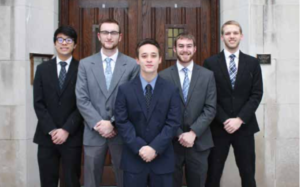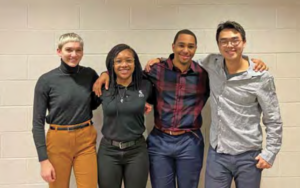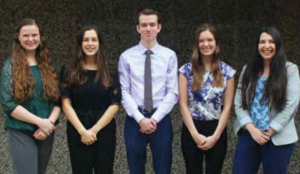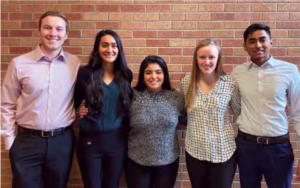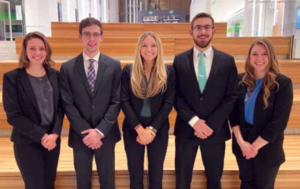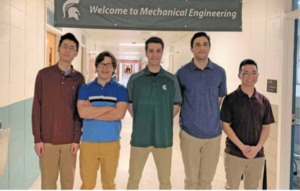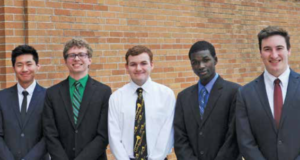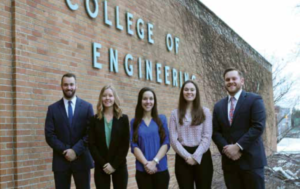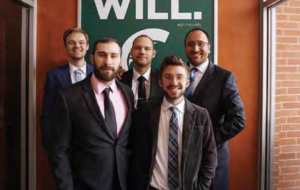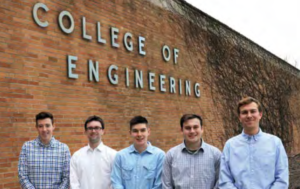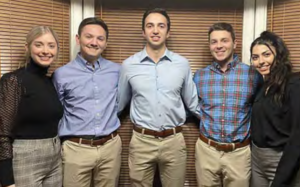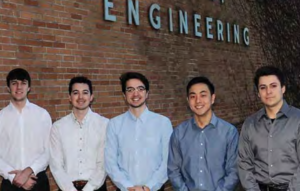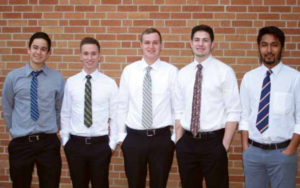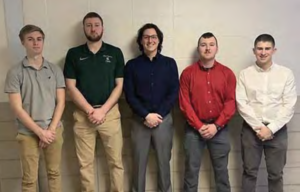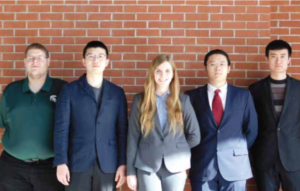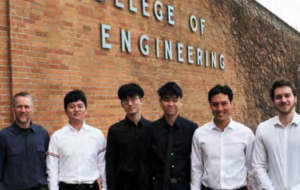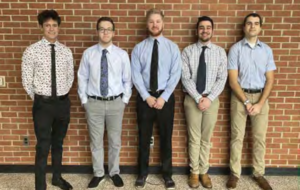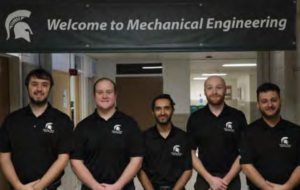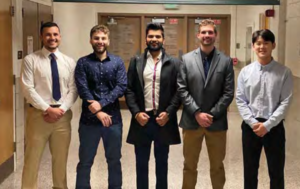One goal of the MSU Mechanical Engineering Program is to educate engineers who are prepared to lead, create, and innovate as their professional or graduate careers evolve. The Mechanical Engineering Design Program is the key element of the curriculum that supports this goal. There are five required design courses in the program which provide our students with eight hands-on, team-based, ‘design, test and build’ projects, and numerous opportunities to practice and refine their written, oral, poster, and video presentation skills. The Design Program in Mechanical Engineering has attracted national recognition on many occasions and helps to distinguish the ME program as one of the best in the country.
For information on becoming a project sponsor, please contact Jim Lang.
The following were the project sponsors and projects for Spring 2020:
MSU Recycling Center: Reduction in Consumption of Plastic Bags
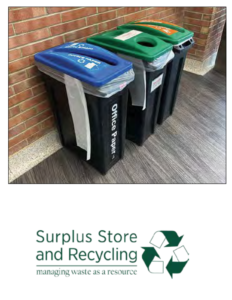 MSU Recycling strives to keep the community clean and green by reusing and recycling materials, collaborating with the community, and educating the public on best practices of recycling. This results in nine million pounds of materials being recycled each year at their Materials Recycling Facility (MRF). The MRF is a plant that receives, sorts, and bales materials received from the many recycling bins located across the MSU campus. In addition to recycling materials, the MSU Surplus Store provides community members with the opportunity to purchase used items, as well as to prevent their own unwanted goods from ending up in a landfill.
MSU Recycling strives to keep the community clean and green by reusing and recycling materials, collaborating with the community, and educating the public on best practices of recycling. This results in nine million pounds of materials being recycled each year at their Materials Recycling Facility (MRF). The MRF is a plant that receives, sorts, and bales materials received from the many recycling bins located across the MSU campus. In addition to recycling materials, the MSU Surplus Store provides community members with the opportunity to purchase used items, as well as to prevent their own unwanted goods from ending up in a landfill.
Despite the plethora of recycling occurring on campus, many of the collection bins for recycled material and trash use plastic bags to collect the material. The bags used often become contaminated with food waste and can result in inefficiencies in the collection and sorting process. In this project, we worked towards a goal of standardizing a new system to reduce the waste of plastic bags and increase the efficiency of the material collection process throughout the Michigan State University campus.
MSU Recycling Center: Pallet Recycling Initiative
 The MSU Recycling center manages the university’s waste with the goal of reducing, reusing, and recycling as much of it as possible. Established in 1988, the Recycling Center is a self-reliant entity within Michigan State University. In 2019, they were able to divert 15 million pounds of waste from reaching local landfills. Their goal is to eventually keep 90% of the received waste from being diverted to landfills. As part of achieving this goal, the recycling center needs to mitigate the quantity of pallets that are disposed of in landfills.
The MSU Recycling center manages the university’s waste with the goal of reducing, reusing, and recycling as much of it as possible. Established in 1988, the Recycling Center is a self-reliant entity within Michigan State University. In 2019, they were able to divert 15 million pounds of waste from reaching local landfills. Their goal is to eventually keep 90% of the received waste from being diverted to landfills. As part of achieving this goal, the recycling center needs to mitigate the quantity of pallets that are disposed of in landfills.
The MSU Surplus Store and Recycling Center collects and processes about 7,500 pallets annually for recycling, resale or waste. Pallets that are in good condition are sold to pallet remanufacturing companies. Pallets that are in poor condition are given away or sent to the landfill. This project identified safe, cost-effective, and efficient ways to disassemble and repurpose pallets. There are multiple ways to effectively recycle pallets, including creating woodchips, disassembling the pallet and selling the wood, or redistributing them directly to specialized recycling centers.
MSU Recycling Center: Food Waste Collection Cart Redesign
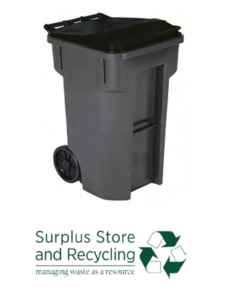 The MSU Surplus Store and Recycling Center, located on Michigan State’s campus in East Lansing, oversees the processing of many different materials. All recycling and food waste from on campus plus recycling from their 24/7 public drop-off center gets taken care of at this facility. All the food collected on campus is either used to power the anerobic digestor or turned into compost. At the center, once the food waste is collected in bins, they are dumped and rinsed with a power washer into a larger dumpster. About 1 million pounds of food waste are processed annually.
The MSU Surplus Store and Recycling Center, located on Michigan State’s campus in East Lansing, oversees the processing of many different materials. All recycling and food waste from on campus plus recycling from their 24/7 public drop-off center gets taken care of at this facility. All the food collected on campus is either used to power the anerobic digestor or turned into compost. At the center, once the food waste is collected in bins, they are dumped and rinsed with a power washer into a larger dumpster. About 1 million pounds of food waste are processed annually.
Our project focused on clean, efficient removal of food waste from the bins located around campus. The process of emptying and cleaning the bins is time-consuming and uses a lot of water and energy. As a continuation from a prior capstone project, the cart needed to be redesigned. It was suggested by the previous group to switch from HDPE plastic to ABS with an LPS coating. We tested different food safe coatings applied to existing bins in order to prevent food from sticking to the sides. This allowed for the removal of many steps, such as heated power washing and transporting the bins back and forth from the recycling center. We tested many different applications to ensure that even the worst food materials, such as peanut butter and pizza, would come off cleanly.
McLaren Greater Lansing: Rehab Gym Adjustable Car
 McLaren Greater Lansing is an acute care hospital with two campuses located in the Lansing area. They are also currently in the process of constructing a new hospital located just south of Michigan State University, which is slated to open in the fall of 2021. The new hospital will include a rehabilitation gym for patients who require Occupational Therapy as a part of their recovery process. Occupational Therapy is a service profession that helps patients learn how to perform everyday tasks with the highest level of independence possible with their current condition. This rehabilitation gym will utilize the adjustable truck cab that we have designed and constructed to practice getting in and out of a car independently once they are discharged from the hospital.
McLaren Greater Lansing is an acute care hospital with two campuses located in the Lansing area. They are also currently in the process of constructing a new hospital located just south of Michigan State University, which is slated to open in the fall of 2021. The new hospital will include a rehabilitation gym for patients who require Occupational Therapy as a part of their recovery process. Occupational Therapy is a service profession that helps patients learn how to perform everyday tasks with the highest level of independence possible with their current condition. This rehabilitation gym will utilize the adjustable truck cab that we have designed and constructed to practice getting in and out of a car independently once they are discharged from the hospital.
Our team researched and purchased a hydraulic lift that was able to support the weight of a patient and a truck cab. The cab had been donated to McLaren for this project. We then attached the lift to the bottom of the truck cab and marked guidelines for different heights to adjust the lift in order to simulate a sedan, crossover, or truck. Our team also designed and manufactured a retractable running board that is attached to the truck cab and can be used if the patient’s vehicle has a running board on it.
MSU Biomechanical Design Research Lab: Scooter Impact Test and Fixture Design
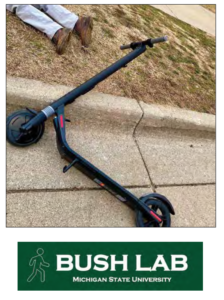 The recent increase in popularity of electric scooters has led to increased concern over the head injuries experienced by users. Currently, there are no well- enforced regulations regarding helmets while riding. This is particularly relevant among young adults on college campuses. In response to this surge in head injuries, Dr. Tamara Reid Bush of the Biomechanical Design Research Laboratory (BDRL) at MSU recognizes the need to research the impact experienced by electric scooter users in the case of a collision. In the BDRL, Dr. Bush and her students develop models, methods, devices, and experiments to apply engineering principles to the human body. This allows them to analyze and better understand how people interact with devices and their surroundings.
The recent increase in popularity of electric scooters has led to increased concern over the head injuries experienced by users. Currently, there are no well- enforced regulations regarding helmets while riding. This is particularly relevant among young adults on college campuses. In response to this surge in head injuries, Dr. Tamara Reid Bush of the Biomechanical Design Research Laboratory (BDRL) at MSU recognizes the need to research the impact experienced by electric scooter users in the case of a collision. In the BDRL, Dr. Bush and her students develop models, methods, devices, and experiments to apply engineering principles to the human body. This allows them to analyze and better understand how people interact with devices and their surroundings.
In order to analyze how a body moves and experiences impact during an electric scooter collision with a stationary object like a curb or parked car, the BDRL required a method of mimicking such a collision with a human surrogate. Our team was tasked with designing and creating a test apparatus and acquiring a mannequin with proper weighting and joint articulation to simulate the collision and analyze the subsequent body motion. The resulting scooter platform with supported mannequin rider can be propelled into the simulated curb, releasing the surrogate upon impact. This allows the BDRL to employ the necessary measurement techniques to analyze the mannequin’s head movement and extent of impact when propelled off the scooter, providing a means for researching the head injuries experienced by electric scooter users.
MSU Adaptive Sports & Recreation Club: Sled Hockey Transfer Platform
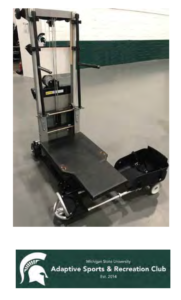 The MSU Adaptive Sports & Recreation Club is a Registered Student Organization that was established in 2014 as a free program open to athletes with physical disabilities, able-bodied volunteers, and academic projects personnel, who are MSU students, employees, alumni, and members of the Greater Lansing community. The program seeks to create and cultivate a physically and socially acceptable space where athletes with physical disabilities and able-bodied volunteers come together to establish an integrated community of peers. The program uses sports to validate the disability experience by eradicating inaccurate societal stereotypes and invalid self-perceptions about disability, while promoting physical and personal health goals. The program adopts a self-determination approach that focuses on athlete autonomy, competence, and relatedness as key facilitators in the process of acquiring self-efficacy in the area of sports and physical activity; skills that can be transferred to other life domains.
The MSU Adaptive Sports & Recreation Club is a Registered Student Organization that was established in 2014 as a free program open to athletes with physical disabilities, able-bodied volunteers, and academic projects personnel, who are MSU students, employees, alumni, and members of the Greater Lansing community. The program seeks to create and cultivate a physically and socially acceptable space where athletes with physical disabilities and able-bodied volunteers come together to establish an integrated community of peers. The program uses sports to validate the disability experience by eradicating inaccurate societal stereotypes and invalid self-perceptions about disability, while promoting physical and personal health goals. The program adopts a self-determination approach that focuses on athlete autonomy, competence, and relatedness as key facilitators in the process of acquiring self-efficacy in the area of sports and physical activity; skills that can be transferred to other life domains.
Our team focused on modifying the existing design to increase the user’s safety and independence. The key design changes included modifying the handrails, the sled hockey docking mechanism, and converting the lift to be electrically controlled. The changes needed to be compact, robust, and universal to accommodate a wide range of users presenting various levels of physical function.
MSU Adaptive Sports & Recreation Club: Inclusive Sports Wheelchair- Phase 3
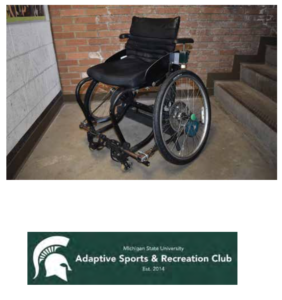 MSU Adaptive Sports and Recreation Club is an inclusive club at MSU that promotes health, wellness, and teamwork through sports for individuals with physical disabilities. Athletes have the opportunity to play a variety of sports in this club including boccia ball, wheelchair hockey, wheelchair rugby, hand-cycling, table tennis, and wheelchair tennis. Through the use of sports, the club strives to improve the physical health of its athletes as well as eliminate the societal stereotypes about disabilities. Though inclusion is the goal of the Adaptive Sports and Recreation Club, individuals can still be excluded from sports based on the capacity of available adaptive sports equipment.
MSU Adaptive Sports and Recreation Club is an inclusive club at MSU that promotes health, wellness, and teamwork through sports for individuals with physical disabilities. Athletes have the opportunity to play a variety of sports in this club including boccia ball, wheelchair hockey, wheelchair rugby, hand-cycling, table tennis, and wheelchair tennis. Through the use of sports, the club strives to improve the physical health of its athletes as well as eliminate the societal stereotypes about disabilities. Though inclusion is the goal of the Adaptive Sports and Recreation Club, individuals can still be excluded from sports based on the capacity of available adaptive sports equipment.
This project is the third phase of a custom-made inclusive sports wheelchair that will be specialized for an ambulatory individual. This project focuses on designing an inclusive sports chair with a durable propulsion method and an effective steering mechanism while keeping the athlete’s dominant arm free for sports play. An example of an intended user of this wheelchair is someone who has experienced a stroke and now has dominant strength on one side of their body. Past phases of this project lacked mobility, reliability, and foot protection during sports. These issues will be addressed in this phase of the project.
Meritor: Crush Spacer Design
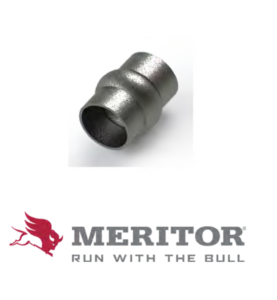 Headquartered in Troy, Michigan, Meritor is a leading global supplier of drivetrain, mobility, braking, and aftermarket solutions for commercial vehicles and industrial products. It has a strong team with years of experience engineering innovative products that offer superior performance, efficiency and reliability. Meritor provides a leading array of differentiated services supporting customers’ products throughout their lifecycle. It provides solutions for fire and rescue, defense, agriculture, heavy haul, and many other groups.
Headquartered in Troy, Michigan, Meritor is a leading global supplier of drivetrain, mobility, braking, and aftermarket solutions for commercial vehicles and industrial products. It has a strong team with years of experience engineering innovative products that offer superior performance, efficiency and reliability. Meritor provides a leading array of differentiated services supporting customers’ products throughout their lifecycle. It provides solutions for fire and rescue, defense, agriculture, heavy haul, and many other groups.
Our team has been tasked with designing a low- cost crush spacer that demonstrates constant load versus displacement characteristics suitable for heavy vehicle operation. Current heavy vehicle designs utilize hardened selectable spacers in axle assembly. Due to tolerance stackups and the limitations of the assembly gauging process, an incorrect length spacer may be selected leading to assembly rebuilds. Through the utilization of CAD and ANSYS, we have designed a crush spacer that adjusts to the tolerance stack-up. Our crush spacer design allows for ease of manufacturing.
Okemos Public Schools/Ingham ISD: Improving Access in the Cafeteria
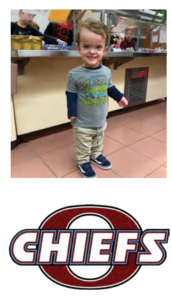 Bennett Woods Elementary School (located in Okemos, Michigan) is in need of efficient cafeteria access for students with physical impairments. One kindergarten student in particular, Gabe, was born with achondroplasia, meaning he is short in stature and his limbs are shorter in relation to the rest of his body. Gabe has recently expressed the desire for more independence and would like to purchase lunch with his peers. Due to his specific needs, Gabe struggles to see any food options as well as to move his food tray along the serving counter. Gabe has had to leave for lunch and receive help from an adult assistant prior to other students going to lunch.
Bennett Woods Elementary School (located in Okemos, Michigan) is in need of efficient cafeteria access for students with physical impairments. One kindergarten student in particular, Gabe, was born with achondroplasia, meaning he is short in stature and his limbs are shorter in relation to the rest of his body. Gabe has recently expressed the desire for more independence and would like to purchase lunch with his peers. Due to his specific needs, Gabe struggles to see any food options as well as to move his food tray along the serving counter. Gabe has had to leave for lunch and receive help from an adult assistant prior to other students going to lunch.
Our team was tasked to adapt the environment of the cafeteria to better suit Gabe in the lunch line. The design allows Gabe to look over the kitchen counter, reach the food, and walk across the lunch line in an efficient manner. The device is also storable, easy to set up, and will not hinder the lunch line process for other students. Since this school has grades K-4, Gabe, as well as other students with certain physical impairments or who are shorter in stature, will be able to use this device for years to come.
Heartwood School/Ingham ISD: Therapeutic Pool Track System
 Heartwood School is a center-based program located in Mason, Michigan and is a part of the Ingham Intermediate School District. Heartwood serves students from 2.5 to 26 years old with moderate to severe cognitive impairments, severe multiple impairments, autism spectrum disorders, and physical impairments. Several of the students are not independent ambulators (walkers) and require some form of adaptive equipment or significant hands-on support to walk. The warm, therapeutic pool provides a great opportunity to work on gait training, strengthening, and motor control.
Heartwood School is a center-based program located in Mason, Michigan and is a part of the Ingham Intermediate School District. Heartwood serves students from 2.5 to 26 years old with moderate to severe cognitive impairments, severe multiple impairments, autism spectrum disorders, and physical impairments. Several of the students are not independent ambulators (walkers) and require some form of adaptive equipment or significant hands-on support to walk. The warm, therapeutic pool provides a great opportunity to work on gait training, strengthening, and motor control.
Our team focused on creating a device that allows non- independent ambulator students the ability to walk in the therapeutic pool without hands-on help from the therapists. This device is designed to be portable inside the room and have the ability to reach all areas of the pool, as well as the ability to reach all depths of the pool. The design can be attached to multiple harnesses to provide use for different sizes and disabilities of students. Our team focused on safety and durability of the device, allowing the weight of any student to be carried, as well as durable against the pool chemicals and room humidity.
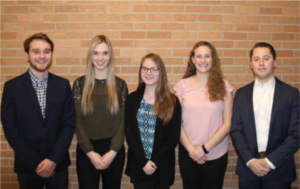
Team Members (L-R): Dr. Christopher McGinnis, Melissa Karas, Gabby Zapolnik, Mikayla Nitoski, Alex Kraski
Heartwood School/Ingham ISD: Revision of Adapt-a-Step Project
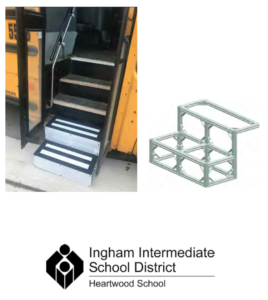 Heartwood School is a center-based program located in Mason, Michigan and is part of the Ingham Intermediate School District. Heartwood serves students from 2.5 to 26 years of age with moderate to severe cognitive impairments, severe multiple impairments, autism spectrum disorders, and physical impairments. Some of the students have yet to develop the ability to reach the first step when entering and exiting the bus for school. To aid the students while they work towards independence, a stepping system, together with an adjustable rail system, were created. These devices reduced the size of the initial step and added upper body support so the students are able to board the bus self- sufficiently.
Heartwood School is a center-based program located in Mason, Michigan and is part of the Ingham Intermediate School District. Heartwood serves students from 2.5 to 26 years of age with moderate to severe cognitive impairments, severe multiple impairments, autism spectrum disorders, and physical impairments. Some of the students have yet to develop the ability to reach the first step when entering and exiting the bus for school. To aid the students while they work towards independence, a stepping system, together with an adjustable rail system, were created. These devices reduced the size of the initial step and added upper body support so the students are able to board the bus self- sufficiently.
Our team was asked to revise the current system in order to increase the mobility, ease of use, and to make it functional across various size bus steps. The new steps were adjusted to allow for transportation on the bus while meeting school bus safety standards, increasing the mobility of the system. The new design is easier to maneuver between the buses and the school, increasing the ease of use for both the school and the students. The step system was made adaptable to accommodate multiple bus sizes so that the students could board a variety of bus models. Finally, a new way of attaching the railing system was implemented to make it more user-friendly.
Heartwood School/Ingham ISD: Revision of Mechanical Pony
 Heartwood School is a local school for children ages 2.5 to 26 with cognitive and physical impairments and autism spectrum disorders. Heartwood School places an emphasis on its specialized curriculum by incorporating the MOVE program in order to improve the quality of life of physically disabled individuals with an emphasis on increasing independence through incorporating opportunities for students to develop and refine their motor skills. One such opportunity to develop motors skills in a fun and engaging way, is through therapeutic horseback riding using a mechanical pony. This pony was designed and built in the spring of 2017 by a mechanical engineering capstone team. First round revisions and enhancements were completed in the spring of 2019. Therapeutic horseback riding helps develop core and lower back strength, which are critical for stability and body motion. Having a realistic design and an attachable TV showing scenery makes the activity feel like a real horseback ride.
Heartwood School is a local school for children ages 2.5 to 26 with cognitive and physical impairments and autism spectrum disorders. Heartwood School places an emphasis on its specialized curriculum by incorporating the MOVE program in order to improve the quality of life of physically disabled individuals with an emphasis on increasing independence through incorporating opportunities for students to develop and refine their motor skills. One such opportunity to develop motors skills in a fun and engaging way, is through therapeutic horseback riding using a mechanical pony. This pony was designed and built in the spring of 2017 by a mechanical engineering capstone team. First round revisions and enhancements were completed in the spring of 2019. Therapeutic horseback riding helps develop core and lower back strength, which are critical for stability and body motion. Having a realistic design and an attachable TV showing scenery makes the activity feel like a real horseback ride.
Our team was asked to develop a regimen to test the capabilities of the mechanical pony as well as determine preliminary signs of failure. A testing regimen can prevent future injuries to the children who use the pony daily and can allow the pony to be maintained and repaired when the risk of injury is lower. We have identified many points for improvement as well as developed a series of tests that would address the concerns presented, increase reliability, and assist in future improvements.
General Motors: Electric Car Sound Design
 One of the significant developments in the automobile industry over the last decade has been the rise of hybrid and electric vehicles. These vehicles have many advantages over traditional internal combustion engine (ICE) automobiles, but there are different challenges in their development. One such challenge is brought by the lower volumes of electric vehicles when compared to traditional ICE cars. While this may seem to be an advantage, the low sound of an electric vehicle can be a hazard to pedestrians and other vulnerable road users. To address this issue, the US government has issued regulations that all electric vehicles produce minimum safe sound levels and pitches. General Motors (GM) is an original equipment manufacturer that has been in operation since 1908. GM owns popular and successful automobile brands, including Chevrolet, Cadillac, GMC, and Buick. GM has been a major contributor to the electric vehicle market with such designs as the new Chevrolet Bolt and is therefore on the cutting edge of electric car sound design.
One of the significant developments in the automobile industry over the last decade has been the rise of hybrid and electric vehicles. These vehicles have many advantages over traditional internal combustion engine (ICE) automobiles, but there are different challenges in their development. One such challenge is brought by the lower volumes of electric vehicles when compared to traditional ICE cars. While this may seem to be an advantage, the low sound of an electric vehicle can be a hazard to pedestrians and other vulnerable road users. To address this issue, the US government has issued regulations that all electric vehicles produce minimum safe sound levels and pitches. General Motors (GM) is an original equipment manufacturer that has been in operation since 1908. GM owns popular and successful automobile brands, including Chevrolet, Cadillac, GMC, and Buick. GM has been a major contributor to the electric vehicle market with such designs as the new Chevrolet Bolt and is therefore on the cutting edge of electric car sound design.
Our team was assigned the task of developing three sounds. Our desire was to produce sounds that meet the specific government regulations, effectively communicate the presence of the vehicle to pedestrians, and yield an emotional response from the listener. The aural experience is a major factor of what makes a particular automobile attractive to the customer, just like paint color or trim. The three sounds we created fulfill the given criteria and our aesthetic desires.
Holt Public Schools/Ingham ISD: Lift for Zeke
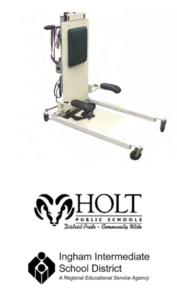 The sponsor for this project is the Holt Public Schools/Ingham Intermediate School District. This organization is a shared community resource that provides a network of support for students with special needs, their families, and educators. This project revolves around Zeke, a freshman student at Holt High School. Zeke is a motivated, intelligent, and outgoing student, who was born without arms or legs, a condition called Quadramelia. He needs assistance for most activities but has independent mobility in his power wheelchair and this independence brings him great joy.
The sponsor for this project is the Holt Public Schools/Ingham Intermediate School District. This organization is a shared community resource that provides a network of support for students with special needs, their families, and educators. This project revolves around Zeke, a freshman student at Holt High School. Zeke is a motivated, intelligent, and outgoing student, who was born without arms or legs, a condition called Quadramelia. He needs assistance for most activities but has independent mobility in his power wheelchair and this independence brings him great joy.
The goal of this project was not just to build a lift, but to have a meaningful impact on Zeke and increase his quality of life. The lift incorporates work from a previous project. Our team revised this lifting device to specifically aid in moving Zeke in and out of his chair safely and comfortably. The previous lifting process required two adults. This new lift enables Zeke to transfer with minimal assistance and thus gives him greater independence. The lift incorporates ergonomic folding arms to facilitate safe transfers and give Zeke adequate support without a harness. The motorized seat allows easy transfer from his wheelchair to a level that he desires for everyday use. The design also allows him to reposition himself to be more comfortable and help regulate his body temperature. Zeke can now be eye level with his peers, lowered to the floor, and his to his favorite height – to see what is in the refrigerator.
Flash Steelworks, Inc.: Flash Process Tubing Handling Apparatus
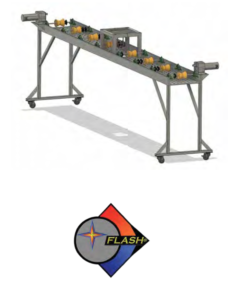 Flash Steelworks, Inc. is an R&D firm that specializes in the development of advanced high-strength steels (AHSS) using their patented heat treating process. The process involves the use of rapid thermal cycling to transform commercial off-the-shelf steel sheets, plates, and tubing into AHSS. Induction technology is used to heat commercial steel to a temperature of about 1070-1200°C. Once the steel has reached this temperature, it is immediately quenched using water. The Flash process is different from conventional heat treating processes because it leverages the natural chemical and morphological heterogeneity of steel to limit carbon migration and carbide dissolution. By limiting the heating time, Flash is able to control carbon migration and carbide dissolution within the steel thereby preserving material heterogeneity to generate a complex, multi-phase steel. This process gives Flash the ability to produce the strongest, most ductile, and most readily weldable steel in the world.
Flash Steelworks, Inc. is an R&D firm that specializes in the development of advanced high-strength steels (AHSS) using their patented heat treating process. The process involves the use of rapid thermal cycling to transform commercial off-the-shelf steel sheets, plates, and tubing into AHSS. Induction technology is used to heat commercial steel to a temperature of about 1070-1200°C. Once the steel has reached this temperature, it is immediately quenched using water. The Flash process is different from conventional heat treating processes because it leverages the natural chemical and morphological heterogeneity of steel to limit carbon migration and carbide dissolution. By limiting the heating time, Flash is able to control carbon migration and carbide dissolution within the steel thereby preserving material heterogeneity to generate a complex, multi-phase steel. This process gives Flash the ability to produce the strongest, most ductile, and most readily weldable steel in the world.
Our team’s focus was to help Flash optimize their heat treating process for steel tubing by redesigning a material handling fixture that is capable of feeding a piece of tubing along a path of motion while simultaneously rotating it. The fixture enables 48” of steel tubing to be processed per minute and also allows the tubing to fully rotate every 1/8” of linear motion using rollers and a motor. These design features ensured that Flash could continue manufacturing high-quality AHSS while also increasing their throughput. Legs were designed for the fixture to provide structural support as well.
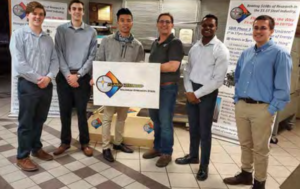
Team Members (L-R): Wyatt Beachy, Caden Swindell, Jin Zhang, Gary Cola (Sponsor), David Abatan, David Kumiega
Microsoft: TeleTech Datacenter Telepresence Robot
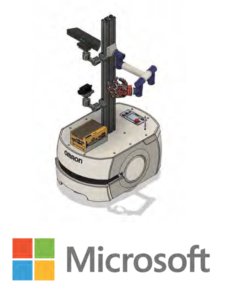 Microsoft is an American-based multinational company that manufactures, develops, licenses, supports, and sells software, electronics, computers, and more. To support its push into cloud computing, Microsoft has an array of datacenters. Datacenter technicians are tasked with maintaining the smooth operation of Microsoft’s datacenter fleet. The datacenter environment is hot, loud, and humid, creating a difficult working environment. To make the technicians’ jobs safer and easier, Microsoft plans to develop datacenter-centric telepresence robots. These robots would save technicians time by performing simple tasks. It is estimated that one- third of their time is spent traveling between server rooms to check on the status of repairs, to find a tool, or to perform a simple task. A telepresence robot could alleviate the burden of these tasks. Furthermore, telepresence robots would enable remote inspection and diagnostics from experts at other sites and provide a platform for security patrols.
Microsoft is an American-based multinational company that manufactures, develops, licenses, supports, and sells software, electronics, computers, and more. To support its push into cloud computing, Microsoft has an array of datacenters. Datacenter technicians are tasked with maintaining the smooth operation of Microsoft’s datacenter fleet. The datacenter environment is hot, loud, and humid, creating a difficult working environment. To make the technicians’ jobs safer and easier, Microsoft plans to develop datacenter-centric telepresence robots. These robots would save technicians time by performing simple tasks. It is estimated that one- third of their time is spent traveling between server rooms to check on the status of repairs, to find a tool, or to perform a simple task. A telepresence robot could alleviate the burden of these tasks. Furthermore, telepresence robots would enable remote inspection and diagnostics from experts at other sites and provide a platform for security patrols.
Our team was tasked with integrating both a 6-axis collaborative robot arm and a vision system into an autonomous mobile platform. The vision system consists of a 360-degree 3D camera as well as another camera mounted to help control and navigate the arm. The vision system is paired with a VR headset to allow a technician to control and navigate the robot and arm remotely using an Xbox controller. All system components were mounted onto the robot and the final system was modeled in CAD. This project was a collaborative effort with an ECE senior capstone team.
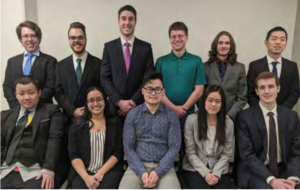
Team Members (L-R): Xhongyi Jiang (ECE), Asha Shekar (ECE), Kevin Le (ECE), Titapa Thaivattanaporn (ECE), John Miller, Back Row: Nik Buchholz, Brian Hofer (ECE), Robert Mothersell, Kevin Hancock (ECE), Taylor Fuhrman, Fanghan Lu
MSU Department of Theatre: Adjustable Height Cutting Table
 The MSU Department of Theatre is challenging the traditional approach in order to create something new, unique and fresh. Every day the Theatre Department spends multiple hours on costume design ideas. The department is in need of an adjustable height cutting table. When the costume is designed and cutting patterns are made for it, the Theatre Department uses a large table to do the layout and design work with the fabric. In order to compensate for students and Theatre Department personnel of varying heights, the Theatre Department currently utilizes stepstools which still leave the users at an awkward height. Also, for students who are taller than average, it is uncomfortable to work on the table at its current fixed height. Furthermore, there is a need for storage space under the table for all of the completed and upcoming work.
The MSU Department of Theatre is challenging the traditional approach in order to create something new, unique and fresh. Every day the Theatre Department spends multiple hours on costume design ideas. The department is in need of an adjustable height cutting table. When the costume is designed and cutting patterns are made for it, the Theatre Department uses a large table to do the layout and design work with the fabric. In order to compensate for students and Theatre Department personnel of varying heights, the Theatre Department currently utilizes stepstools which still leave the users at an awkward height. Also, for students who are taller than average, it is uncomfortable to work on the table at its current fixed height. Furthermore, there is a need for storage space under the table for all of the completed and upcoming work.
Our Team has been tasked with creating a 4’x 12’ adjustable height table. The table needs to adjust from a height of 32” to 44”. The adjustment should be powered by a mechanism that can be controlled using a motor. Controls of such a mechanism can be any type of directional switches. The table should be able to support 500 pounds or more. Due to the storage space restriction, the mechanism cannot be bulky or take up too much space under the table. The table design should also have a cork top for pinning fabric. Our team will be fulfilling all these design constraints and delivering a product that will serve the Theatre Department and the community for years to come.

Team Members (L-R): Yeeun Lee, Niranjan Kulkarni, Naif Alzahrani, Hongxiang Chang, Vincent Pernicano
MSU Department of Theatre: Automated Metal Cleaner
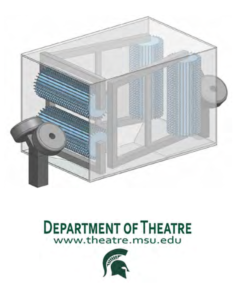 The MSU Department of Theatre (DoT) offers not only a one-of-a-kind self-selected undergraduate education but also new and inspiring plays. In the 2019-2020 season, the DoT has presented 12 different, thought-provoking and trailblazing productions. MSU has the unique opportunity to create its very own sets for theatre productions and the College of Music Opera program within the 9,370-square-foot scene shop. Within the shop, the equipment, tools, and technology range from a complete welding area to a full-size paint studio.
The MSU Department of Theatre (DoT) offers not only a one-of-a-kind self-selected undergraduate education but also new and inspiring plays. In the 2019-2020 season, the DoT has presented 12 different, thought-provoking and trailblazing productions. MSU has the unique opportunity to create its very own sets for theatre productions and the College of Music Opera program within the 9,370-square-foot scene shop. Within the shop, the equipment, tools, and technology range from a complete welding area to a full-size paint studio.
Our team was tasked with designing a device capable of cleaning metal beams by removing oil and residue buildup. When creating the scenery for productions, the DoT uses metals of varying geometries for aesthetic and structural purposes. Prior to building this device, the process to clean the metals was inefficient and tedious. With this revolutionizing method of cleaning, the designers at the scene shop will be able to clean and build scenery in a fraction of the time it used to take. The device functions like a car wash, in which a piece of metal is fed into one end, goes through a full cleansing and drying process, then emerges fresh and clean from the other end.
NASA Marshall Space Flight Center: High Performance Nuclear Thermal Propulsion
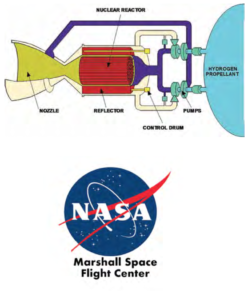 NASA Marshall Space Flight Center (MSFC) is located in Huntsville, Alabama. NASA MSFC is a United States government research center for spacecraft propulsion, founded on July 1, 1960. Its first mission was developing the Saturn launch vehicles for the Apollo program. NASA seeks more research on the solar system and the next goal is to make it to Mars. In that process a Nuclear Thermal Propulsion rocket (a fission reactor heating hydrogen or other substances that accelerate through a nozzle) is one approach to making the trip to Mars safe, affordable, and viable.
NASA Marshall Space Flight Center (MSFC) is located in Huntsville, Alabama. NASA MSFC is a United States government research center for spacecraft propulsion, founded on July 1, 1960. Its first mission was developing the Saturn launch vehicles for the Apollo program. NASA seeks more research on the solar system and the next goal is to make it to Mars. In that process a Nuclear Thermal Propulsion rocket (a fission reactor heating hydrogen or other substances that accelerate through a nozzle) is one approach to making the trip to Mars safe, affordable, and viable.
Our team worked on a research project for a second generation Nuclear Thermal Propulsion (NTP) unit. The NTP system would be used for a rocket that would journey to Mars and back. The research included one-dimensional analysis calculations, regarding heating hydrogen propellant through the use of fissioning liquid uranium in a rotating cylinder. With the remainder of the given time, an investigation of the pressure of the H2 from the propellant tank to the H2 pump, and the pressure requirement from the H2 pump to the blades for fuel cylinder rotation was in progress We began an investigation of the pressure of the H2 from the propellant tank to the H2 pump, and the pressure requirement from the H2 pump to the blades for fuel cylinder rotation. Due to the lack of time, calculations, such as the viscosity and heat transfer coefficient of liquid uranium at 5000k, were not completed. We left them in variable form so that it will be easy to insert the values when they are known.
NASA Marshall Space Flight Center: Tensile Tester for Thermal Protection Systems
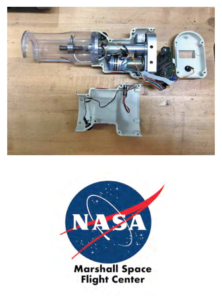 The NASA Marshall Space Flight Center has been in operation since 1960 and is at the forefront of space exploration in the United States. As one of NASA’s largest field centers, this facility specializes in the propulsion systems for space exploration; its focus is on traditional solid and liquid propulsion systems. Utilizing the best propulsion technologies, Marshall has been developing NASA’s heavy-lift Space Launch System (SLS). This system is the backbone of NASA’s exploration plans and is the only rocket capable of carrying people to the Moon and eventually Mars. NASA’s Marshall Space Flight Center’s expansive capabilities and state-of-the-art facilities are critical for every aspect of NASA’s mission for future space endeavors.
The NASA Marshall Space Flight Center has been in operation since 1960 and is at the forefront of space exploration in the United States. As one of NASA’s largest field centers, this facility specializes in the propulsion systems for space exploration; its focus is on traditional solid and liquid propulsion systems. Utilizing the best propulsion technologies, Marshall has been developing NASA’s heavy-lift Space Launch System (SLS). This system is the backbone of NASA’s exploration plans and is the only rocket capable of carrying people to the Moon and eventually Mars. NASA’s Marshall Space Flight Center’s expansive capabilities and state-of-the-art facilities are critical for every aspect of NASA’s mission for future space endeavors.
Our team was tasked with the implementation of a redesigned portable tensile testing machine for the Thermal Protection System (TPS) on the SLS. This device is utilized for testing the adhesion of the insulating foam after it has been applied to the exterior of the Launch Vehicle Stage Adaptor and Core Stage components of the rocket. This foam is responsible for maintaining a stable fuel temperature when exiting the atmosphere and entering into cold space. The current device used is outdated and no longer produced, so we created a new machine adapted to the current test procedure. In order to verify the adhesion of the TPS, the tensile tester pulls on test tabs that are installed in the foam. Surpassing a force threshold ensures the integrity of foam application and allows for the next stages of assembly.
MSU Department of Mechanical Engineering: Modular Work Station for SAE Racing Teams
 The College of Engineering Baja and Formula Racing Teams are student organizations that participate in the nationwide Society of Automotive Engineers (SAE) design competitions. Last-minute repairs and adjustments to the vehicles are common in this fast-paced environment. Previously, the teams had to load and fasten the required equipment to the trailer that was hauled to the competitions.
The College of Engineering Baja and Formula Racing Teams are student organizations that participate in the nationwide Society of Automotive Engineers (SAE) design competitions. Last-minute repairs and adjustments to the vehicles are common in this fast-paced environment. Previously, the teams had to load and fasten the required equipment to the trailer that was hauled to the competitions.
Our team focused on designing a modular work station that could serve as a welding and machining area. This movable device can mount tooling and machines, such as a welder, mill, drill press, and other accessories as requested by the teams. We also worked to ensure that the system would be secure in rough driving conditions. The station was designed using NX 11, and analyzed using Altair Inspire. The team successfully created a design that was safe, modular, and of use for years to come.
MSU Solar Racing Team: Electric Motor Dynamometer
 The MSU Solar Racing Team (MSU SRT) was founded in 2000 with a grant from the College of Engineering at Michigan State University. After several generations of team members and through research/support from other teams, MSU SRT built its first car, named Brasidius, in 2010. Between 2010 and 2012 two improved versions of Brasidius were made. In 2014 the team completed a new vehicle called Leonidas, and improved that vehicle in the subsequent years. In 2018, the team began designing the first multi-occupant, coupe-style vehicle called Aurora, which was completed in July 2019. The team has continued making improvements on the car for upcoming competitions to be held in the summer of 2020.
The MSU Solar Racing Team (MSU SRT) was founded in 2000 with a grant from the College of Engineering at Michigan State University. After several generations of team members and through research/support from other teams, MSU SRT built its first car, named Brasidius, in 2010. Between 2010 and 2012 two improved versions of Brasidius were made. In 2014 the team completed a new vehicle called Leonidas, and improved that vehicle in the subsequent years. In 2018, the team began designing the first multi-occupant, coupe-style vehicle called Aurora, which was completed in July 2019. The team has continued making improvements on the car for upcoming competitions to be held in the summer of 2020.
A major factor that has prevented MSU SRT from success in past years’ competitions has been a lack of testing. The goal of this project was to build an electric motor dynamometer that will aid in analyzing MSU SRT’s propulsion system. In order to accomplish this, the team had to build a custom motor stand, create a method of applying loads to the motor, configure the motor controller to record desired inputs/outputs, and analyze the recorded results from tests. Team members for this project had to be skilled in control systems, electric motor functionality, motor controller operations, electrical wiring, Arduino coding, and manufacturing processes.
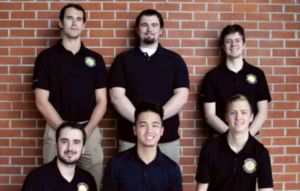
Team Members (L-R) – Front Row: Kevin Kinsey, Brandon Chan, Zachary Kubiak – Back Row: Trystan Melnyk Royal, Connor Wilson, Zach Kupa
Salt Yoga: Core Roller
 Salt Yoga, located in East Lansing, Michigan, is a yoga studio that offers a variety of different classes for people of any athletic ability and strength. The studio is pursuing a simple and innovative product to create a new take on a rigorous core workout. This product allows for more engaging abdominal workouts. The goal is to help bring to life a simple idea for a novel device. The mission is to make the customers’ workout experience more challenging and beneficial. The unique design engages muscles that are not normally used in other abdominal exercises.
Salt Yoga, located in East Lansing, Michigan, is a yoga studio that offers a variety of different classes for people of any athletic ability and strength. The studio is pursuing a simple and innovative product to create a new take on a rigorous core workout. This product allows for more engaging abdominal workouts. The goal is to help bring to life a simple idea for a novel device. The mission is to make the customers’ workout experience more challenging and beneficial. The unique design engages muscles that are not normally used in other abdominal exercises.
Our team was tasked with transforming a concept for a portable core roller using rigorous design, build, and test methods. The device will help strengthen the core muscles through a vigorous workout for users with any level of athletic ability and strength. The core roller enables versatile workout motion by using one’s hands or feet. In addition, the core roller can be used on a wide array of surfaces. The product’s functionality allows the individual to perform many different workouts. The core roller makes it possible to have a powerful core workout anywhere you go.
Terphane: Food Take-Out & Delivery Container System
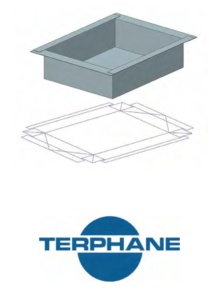 Terphane is a packaging materials company that manufactures specialty polyester films in the US and Brazil. Terphanes’s films are thin (12 micron) and have special coatings that allow them to heat seal to themselves and to other polyesters. These films are also capable of high temperatures, such as those in an oven or microwave. In order to grow their business, Terphane is using these films as liners for takeout food containers. By integrating its film with paperboard and developing mechanisms that can be used in a food retail environment to assemble the take-out container, they can significantly reduce the cost and environmental impact of take-out packaging.
Terphane is a packaging materials company that manufactures specialty polyester films in the US and Brazil. Terphanes’s films are thin (12 micron) and have special coatings that allow them to heat seal to themselves and to other polyesters. These films are also capable of high temperatures, such as those in an oven or microwave. In order to grow their business, Terphane is using these films as liners for takeout food containers. By integrating its film with paperboard and developing mechanisms that can be used in a food retail environment to assemble the take-out container, they can significantly reduce the cost and environmental impact of take-out packaging.
Our team was tasked with developing a low-cost, easy-to-use system utilizing paperboard, film, and a sealant lamination to create a food delivery container for use in the retail shop environment. A simple machine was designed to use heat in order to construct the container from a flat sheet of laminated paperboard. The machine was low cost at less than $100, operator friendly, and able to be plugged into an outlet. The driving force behind this project was to reduce the environmental impact of take-out and delivery containers which are currently on an upward growth trajectory. Effectively converting a flat sheet into a container onsite saves on cost and energy of shipping.
MSU Department of Mechanical Engineering: HPVC Frame Design

Michigan State University’s Human Powered Vehicle Challenge (HPVC) Team participates annually in a competition held at ASME’s E-Fests. The competition brings together teams from many locations to compete in an endurance race and drag race using a two- or three-wheeled human powered vehicle. MSU has hosted the event in this region in 2019 and 2020, and doing well in the event can be a huge source of pride for the MSU College of Engineering. The HPVC Team is composed of a group of MSU engineering students, each dedicating their time to the project and balancing their roles on the team with coursework and other commitments. As the team is relatively new, designing and manufacturing a custom frame has not been feasible yet. Instead, the current frame is a purchased part, not optimized for this type of competition.
Our team has been tasked with designing a new frame that will strengthen the performance of the vehicle. One aspect of the competition is the soundness of design, so the team designed a frame from scratch while documenting their justification for design decisions. The new design will help maximize the performance of the vehicle, so turning radius, weight, comfort, possibility for attachments, etc. were all considered as part of the design process.
MSU Department of Mechanical Engineering: HPVC Truss Bike Frame
 Each year, ASME holds several Human Powered Vehicle Challenge (HPVC) competitions. This year, HPVC-North will be held in East Lansing. In each competition, there are men’s and women’s drag races and an endurance race. The drag race focuses on speed, whereas the endurance race focuses on maneuvering through different terrain and transporting a small package which simulates groceries. Furthermore, each team must submit a written report that contains information about the design choices. The vehicle must be designed with safety in mind, and a roll cage must be built to protect the driver in the event of an accident.
Each year, ASME holds several Human Powered Vehicle Challenge (HPVC) competitions. This year, HPVC-North will be held in East Lansing. In each competition, there are men’s and women’s drag races and an endurance race. The drag race focuses on speed, whereas the endurance race focuses on maneuvering through different terrain and transporting a small package which simulates groceries. Furthermore, each team must submit a written report that contains information about the design choices. The vehicle must be designed with safety in mind, and a roll cage must be built to protect the driver in the event of an accident.
Our team has focused on designing a new frame for next year’s competition. The frame is redesigned from scratch using a truss system. Different materials were researched for their weight and cost. We created a CAD model of the frame while also performing calculations, including finite element analysis, dynamic calculations, center of gravity calculations, and weight distribution. The design created is something that could be implemented into next year’s competition.
MSU Department of Mechanical Engineering: Human Powered Vehicle Frame Design
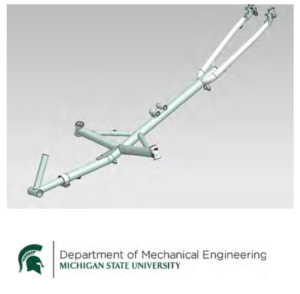 The Human Powered Vehicle Challenge (HPVC) provides students a chance to develop a sustainable, practical, and alternative solution to transportation for underdeveloped or inaccessible regions of the world where human powered transportation might be the only option. The goal of the challenge is to work in teams to design and build engineered vehicles for everyday use which requires humans to provide the force necessary for motion. This Challenge occurs yearly and universities from across the nation participate. The designs consist of a two- or three-wheeled bicycle with roll cage, gears, and aerodynamic attachments.
The Human Powered Vehicle Challenge (HPVC) provides students a chance to develop a sustainable, practical, and alternative solution to transportation for underdeveloped or inaccessible regions of the world where human powered transportation might be the only option. The goal of the challenge is to work in teams to design and build engineered vehicles for everyday use which requires humans to provide the force necessary for motion. This Challenge occurs yearly and universities from across the nation participate. The designs consist of a two- or three-wheeled bicycle with roll cage, gears, and aerodynamic attachments.
The focus of this project was to redesign the main frame for the bicycle. To do so, we were tasked with developing an entirely new concept for it. This consisted of having a safe, lightweight, manufacturable tadpole bike frame for the competition, performing research to back up any of our design decisions to improve speed, power, balance, and comfort. Lastly, the final design had to incorporate attachments for possible aerodynamic parts and an RPS.

Team Members (L-R): Jake Fosmoen, Gregorio Gaio, Cameron Barghahn, Amarildo Alijaj, Rourke Brummette
MSU Department of Mechanical Engineering: ASME HPVC Energy Storage Device Concept
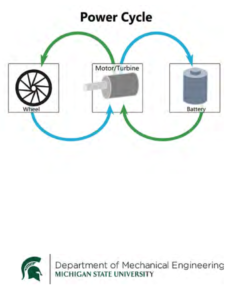 The MSU Department of Mechanical Engineering focuses on teaching and research about devices and systems that utilize motion and energy to accomplish a wide range of objectives. MSU ME faculty, students, and graduates work to develop technologies in fields such as vehicle design, plumbing systems, robotics, biomechanics, manufacturing methodologies, and more. Undergraduate studies in the department’s classes often focus on the process of applying engineering knowledge to design projects, many of which are featured at Design Day.
The MSU Department of Mechanical Engineering focuses on teaching and research about devices and systems that utilize motion and energy to accomplish a wide range of objectives. MSU ME faculty, students, and graduates work to develop technologies in fields such as vehicle design, plumbing systems, robotics, biomechanics, manufacturing methodologies, and more. Undergraduate studies in the department’s classes often focus on the process of applying engineering knowledge to design projects, many of which are featured at Design Day.
One ongoing research area for the MSU Department of Mechanical Engineering is participation in the American Society of Mechanical Engineers’ Human Powered Vehicle Challenge. Our team was tasked with designing an electric energy reclamation system to be used during an endurance race to allow energy generated by the rider to be carried over between riders. Our approach was to emulate the regenerative braking systems used in Formula 1 racing. Energy that would be dissipated during active slowdown of the vehicle is instead diverted into a device that generates electricity, stored in a battery, that can later be sent back through the device, which then acts as a motor driving the vehicle forward. In accordance with ASME HPVC rules, the energy storage device’s battery can be drained, so that all the energy in the vehicle is produced by a human rider over the course of the event.
MSU Department of Mechanical Engineering: HPVC Energy Storage Device Concept Design
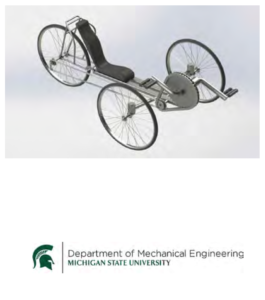 This year, Michigan State University’s Mechanical Engineering Department will host the Human Powered Vehicle Competition (HPVC) for the north region teams of North America. This competition provides an opportunity for teams to design and develop operable human powered vehicles capable of transportation. Recently, the idea of an energy storage device was considered for use during the competition. With the implementation of this rule, competitors will need to assess new design tasks associated with the energy storage device, thus enhancing the engineering development process.
This year, Michigan State University’s Mechanical Engineering Department will host the Human Powered Vehicle Competition (HPVC) for the north region teams of North America. This competition provides an opportunity for teams to design and develop operable human powered vehicles capable of transportation. Recently, the idea of an energy storage device was considered for use during the competition. With the implementation of this rule, competitors will need to assess new design tasks associated with the energy storage device, thus enhancing the engineering development process.
Our team was asked to evaluate prospective potential energy storage concepts for the Human Powered Vehicles. We have developed a potential energy storage device that is capable of storing energy, which could then be used to propel the vehicle from rest to 3 km/hr. We also considered the feasibility of this function when the device begins with zero stored energy and all input energy originates from the human operator. With the use of this device, a novel energy storage method will be introduced to HPVC that is capable of providing energy to the vehicle without any additional energy from the operator. The success of this concept will enable cyclists to speed up even when the cyclist input is minimal.

Team Members (L-R): Joerg Petrasch, Scott Maxey, Michelle Huang, Cameron Ploss, Adam Goodes, Justin Gilgallon
MSU Department of Mechanical Engineering: Bicycle Kinetic Energy Storage Device
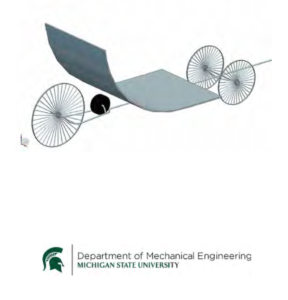 This project was sponsored on behalf of the ASME’s Human Powered Vehicle Challenge (HPVC). Many underdeveloped and inaccessible parts of the world experience difficulties with transportation, where vehicles that operate using a chemical or electrical fuel simply aren’t viable. The overarching goal of the HPVC is to allow young engineers opportunities to prove themselves in the application of engineering practices by designing human powered vehicles and competing against each other. In turn, they would develop designs that could allow for a transformation in local transportation in regions that need it the most.
This project was sponsored on behalf of the ASME’s Human Powered Vehicle Challenge (HPVC). Many underdeveloped and inaccessible parts of the world experience difficulties with transportation, where vehicles that operate using a chemical or electrical fuel simply aren’t viable. The overarching goal of the HPVC is to allow young engineers opportunities to prove themselves in the application of engineering practices by designing human powered vehicles and competing against each other. In turn, they would develop designs that could allow for a transformation in local transportation in regions that need it the most.
Our team was asked to assist in the design of an energy storage system for the human powered vehicle, with an emphasis on storing excess energy in a kinetic form for later use. It was decided that the best form of kinetic storage to explore and design was a flywheel system; this was due to a combination of factors. A history of industrial research and use, many existing designs from which to draw inspiration, and the relative simplicity of the device all led us to pursue this as our design solution. Some of the primary goals decided on by the team were to ensure a satisfactory level of safety with the device, together with reliability and ease-of-use.
MSU Department of Mechanical Engineering: HPVC Energy Storage Device
 Founded in 1880, the American Society of Mechanical Engineers (ASME) is a professional, non-profit engineering society that helps develop solutions to real- world challenges by allowing collaboration and consistency across all engineering disciplines. With its nearly 600 codes and standards implemented in more than 100 countries, ASME’s 100,000+ members are able to utilize widely accepted industry practices in order to develop new technology while also creating a safer world. The Human Powered Vehicle Competition (HPVC) allows ASME to apply these codes and standards to the development of efficient, sustainable, and safe transportation methods.
Founded in 1880, the American Society of Mechanical Engineers (ASME) is a professional, non-profit engineering society that helps develop solutions to real- world challenges by allowing collaboration and consistency across all engineering disciplines. With its nearly 600 codes and standards implemented in more than 100 countries, ASME’s 100,000+ members are able to utilize widely accepted industry practices in order to develop new technology while also creating a safer world. The Human Powered Vehicle Competition (HPVC) allows ASME to apply these codes and standards to the development of efficient, sustainable, and safe transportation methods.
The rules of the competition require the vehicle to store energy provided by the rider for reuse when desired. Other rules require that the vehicle come to a complete stop for three seconds every lap and to start the event with zero stored energy. The main goal for the energy transmitting device was to be able to accelerate the vehicle from rest to 3 km per hour twice per lap. Another requirement was to make sure the energy is released at the correct time in order maximize the safety of the rider, as well as the efficiency and reliability of the vehicle. Our group designed and analyzed an energy transmitting device that can transfer kinetic, potential, and chemical energy from the rider to the storage device and from the storage device back into the vehicle. This device will assist riders with a burst of energy when they need it most.
MSU Department of Mechanical Engineering: E-Bike Dynamometer
 The Michigan State University Mechanical and Electrical Engineering departments focused on a project involving an electric bike dynamometer. This project is a continuation of a previous capstone project from the fall of 2019. The electric bike has two sources of power: the mechanical power from the rider and the electric power from the motor. The dynamometer had to be able to sense a range of loads and speeds that a rider would experience in real life.
The Michigan State University Mechanical and Electrical Engineering departments focused on a project involving an electric bike dynamometer. This project is a continuation of a previous capstone project from the fall of 2019. The electric bike has two sources of power: the mechanical power from the rider and the electric power from the motor. The dynamometer had to be able to sense a range of loads and speeds that a rider would experience in real life.
The dynamometer measures the power output of the rear wheel of the bike for different load conditions. The goals of this project involved fixing and improving the previous design to provide accurate and realistic results. The first issue that was fixed was properly mounting the load cell to the motor. The second issue was constructing a more stable dynamometer structure. Fixing these two issues allowed for easier use and implementation of the original control strategy. The original control strategy was to account for different grades of roads along with different masses of bikes and riders. The varying resistance from the dynamometer can recreate these parameters for different simulated conditions.

Team Members (L-R): Ian Shelby (ECE), Adam Steslicki (ECE), Nicholas Pak, Komal Dixit (ECE), Samuel Addy, Evan Drew
MSU Department of Mechanical Engineering: Bicycle Frame Manufacturing
 In order for low volume bicycle manufacturers to meet production demands and remain profitable, they must have an efficient system for manufacturing bicycle frames. It is important that a manufacturer is able to repeatedly produce bicycle frames, with slight adjustments. These adjustments include differences in sizing and frame geometry. If a manufacturer is able to use the same tools, fixtures, and process from frame to frame, its profits will increase greatly.
In order for low volume bicycle manufacturers to meet production demands and remain profitable, they must have an efficient system for manufacturing bicycle frames. It is important that a manufacturer is able to repeatedly produce bicycle frames, with slight adjustments. These adjustments include differences in sizing and frame geometry. If a manufacturer is able to use the same tools, fixtures, and process from frame to frame, its profits will increase greatly.
Our team was provided CAD models for a bicycle frame and was tasked with bringing the design to life. This included verifying CAD models and creating fixtures that streamlined the assembly process. The purpose of these fixtures is to help consistently replicate a specific bicycle frame but be adjustable to other frame plans in the future. We developed a manufacturing plan to allow for low volume production at a rate of one frame per day.
Pratt Miller Engineering: Formula SAE Drag Reduction System (DRS)
 Formula SAE is a collegiate design competition that challenges students to design, manufacture, and race an open-wheeled racecar against universities from around the world. Cars from universities such as Michigan State compete in dynamic events to evaluate their performance within areas of design, control, and, most notably, in aerodynamic performance.
Formula SAE is a collegiate design competition that challenges students to design, manufacture, and race an open-wheeled racecar against universities from around the world. Cars from universities such as Michigan State compete in dynamic events to evaluate their performance within areas of design, control, and, most notably, in aerodynamic performance.
The objective of the Drag Reduction System is to improve the performance of Michigan State University’s 2020 Formula SAE racecar – the SR-20. The Drag Reduction System improved lap times by reducing the overall vehicle drag when activated within its open state. The aerodynamic airfoils on the vehicle’s rear wing were made to be adjustable, powered by a control module that triggers a linear pneumatic actuator over the vehicle’s CAN-Bus Controller Area Network – Bus. The stroke of the actuator acts through a linkage system to optimize the angle of attack of each airfoil when the DRS system is adjusted between open or closed states. With DRS, the time saved, owing to decreased time spent on track straightaways, reduces the time penalty induced by weight and drag in a well-designed vehicle.
Technical support was provided by Pratt Miller Engineering – a product development company specializing in complex applications within motorsports, defense, and specialized software solutions. PME provides engineering and design, prototyping, low-rate production, and digital solutions.
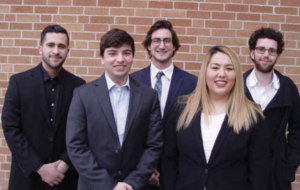
Team Members (L-R): Minir Jakupi, Christian Abbate, Brendan Frenczli, Victoria Farrell, Timur Aminov
MSU Baja Racing Team: On-Vehicle Transmission Testing System
 The MSU Baja Racing Team is a Society of Automotive Engineers collegiate design team that designs, builds, and races an off-road buggy in competitions around the country. The team has competed in off-road vehicle racing since the 1980s. The focus of the team is to develop engineering students and provide them with a chance to apply their classroom knowledge to a complicated real-world problem.
The MSU Baja Racing Team is a Society of Automotive Engineers collegiate design team that designs, builds, and races an off-road buggy in competitions around the country. The team has competed in off-road vehicle racing since the 1980s. The focus of the team is to develop engineering students and provide them with a chance to apply their classroom knowledge to a complicated real-world problem.
Previously, Michigan State Baja has used Continuously Variable Transmissions (CVT) designed for snowmobiles and junior dragsters but has made the move to using a custom CVT on their car this year. With the increased tuning capabilities offered by the custom CVT, our team designed and programmed an on-vehicle transmission testing system for the team to use. The system accurately measures the rotational speed of both portions of the CVT while also measuring the linear distance the CVT changes during ratio shifts. The system is also set up to measure belt speed and temperature in future testing. All sensors were designed to fit into a housing that mounts directly to the vehicle and enables the system to be transferred to future team vehicles. The completed project will allow the MSU Baja Race team to improve their CVT tuning, allowing for a faster and more efficient vehicle.
MSU Baja Racing Team: Shock Dynamometer
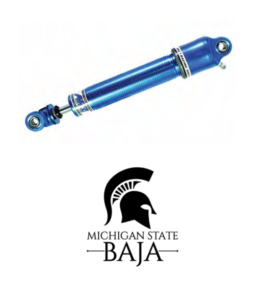 The MSU Baja Racing Team is a Society of Automotive Engineers collegiate design team that designs, builds, and races an off-road buggy in competitions around the country. The team has competed in off-road vehicle racing since the 1980s. The focus of the team is to develop engineering students and provide them with a chance to apply their classroom knowledge to a complicated real- world problem.
The MSU Baja Racing Team is a Society of Automotive Engineers collegiate design team that designs, builds, and races an off-road buggy in competitions around the country. The team has competed in off-road vehicle racing since the 1980s. The focus of the team is to develop engineering students and provide them with a chance to apply their classroom knowledge to a complicated real- world problem.
A shock dynamometer was designed to help the team accurately measure the damping rate of shocks, which are a key suspension component. This tool relates the velocity of the shock plunger to a resistive force. Using this dynamometer, the team was able to quantitatively design a better suspension system and help future team members develop a deeper understanding of vehicle dynamics.
MI Department of Natural Resources (DNR): Straits State Harbor Renewable Energy Generation
 Michigan Department of Natural Resources Parks and Recreation Division (DNR) is charged with the care of 19 state harbors, 103 state parks, and over 100 state forest campgrounds. The Straits State Harbor is one of the locations and is the focus of this project. Operating costs for a typical DNR managed harbor can reach up to $6,000 a month when the ice-suppression bubblers are running. As part of the development of the harbor, in 2007 the DNR invested in eight windmill turbines to supplement the harbor’s energy requirements. The windmills led the harbor to become one of the most eco-friendly in the State of Michigan. However, currently only two of the eight windmills are functioning. The wind turbine manufacturer is no longer in business, so it has been difficult finding a company to repair them, meanwhile maintenance costs continue to increase.
Michigan Department of Natural Resources Parks and Recreation Division (DNR) is charged with the care of 19 state harbors, 103 state parks, and over 100 state forest campgrounds. The Straits State Harbor is one of the locations and is the focus of this project. Operating costs for a typical DNR managed harbor can reach up to $6,000 a month when the ice-suppression bubblers are running. As part of the development of the harbor, in 2007 the DNR invested in eight windmill turbines to supplement the harbor’s energy requirements. The windmills led the harbor to become one of the most eco-friendly in the State of Michigan. However, currently only two of the eight windmills are functioning. The wind turbine manufacturer is no longer in business, so it has been difficult finding a company to repair them, meanwhile maintenance costs continue to increase.
Our group was tasked with analyzing all available data on the windmills and geography of the region. At which point, we would provide a recommendation for the DNR to either effect repairs on the current windmills, or to replace them with an entirely new alternative energy system.
Michigan AgrAbility: Log Trough
 Michigan AgrAbility assists workers in the agricultural industry with disabilities, both physical and mental, to allow them to continue pursuing the occupation they enjoy. These disabilities create daily challenges for Michigan farmers and can burden them with financial challenges, lifestyle changes, and an uncertain future. AgrAbility works closely with Michigan Rehabilitation Services to eliminate such barriers through the development and design of specialized farming equipment and tools. This allows farmers with disabilities to continue to work independently and experience an improved quality of life.
Michigan AgrAbility assists workers in the agricultural industry with disabilities, both physical and mental, to allow them to continue pursuing the occupation they enjoy. These disabilities create daily challenges for Michigan farmers and can burden them with financial challenges, lifestyle changes, and an uncertain future. AgrAbility works closely with Michigan Rehabilitation Services to eliminate such barriers through the development and design of specialized farming equipment and tools. This allows farmers with disabilities to continue to work independently and experience an improved quality of life.
Our team was tasked with designing a log trough for a family that relies on a wood furnace to heat their home during the winter months. The trough had to accommodate logs ranging from three to twenty-eight inches in diameter, and ten to twelve feet in length. Manually moving a log of this size is no easy task, making it necessary to design a mechanism that moves the log forward and backward. In addition, it enables the log to be clamped and cut as desired. By hydraulically assisting the movement of the log, the amount of physical labor required to perform this important task was significantly reduced. The implementation of this project has considerably improved the log splitting capacity of the family.

Team Members (L-R): Ned Stoller (Industry Advisor), Marcell Benkes-Toth, Taylor Jacobs, Kurtis Potier, Helen Miller, Jacob Sickelsteel
Swagelok: Alignment Fixture for Tube Bending
 Swagelok is a $2 billion dollar company that develops innovative solutions for fluids systems operating on a local and global level. Our group worked with the Farmington Hills location. This location is an innovation center specializing in fabricating high-pressure products, tubing and tools, and welding systems. The wide range of projects encountered by this facility requires tools that promote accurate and rapid prototyping.
Swagelok is a $2 billion dollar company that develops innovative solutions for fluids systems operating on a local and global level. Our group worked with the Farmington Hills location. This location is an innovation center specializing in fabricating high-pressure products, tubing and tools, and welding systems. The wide range of projects encountered by this facility requires tools that promote accurate and rapid prototyping.
The goal of the project was to design and manufacture a universal alignment and measurement fixture used for different sizes of stainless-steel tube bending. The process heavily relied on human visuals for phase alignment. When multiple bends were required, this process often became a trial and error process resulting in material and time wasted. The created fixture eliminates the possibility for human error in the tube-bending process. The fixture allows the user to accurately bend tubing with intuitive and easy-to-use alignment features. Moreover, the size and weight of the fixture promote easy transportation. The device is expected to increase internal efficiency at Swagelok.

Team Members (L-R): Christopher Kiesling (Sponsor), Karl Havens, Rachel Arnold, Pankti Tank, Jeremy Coleman, Christopher Fadanelli
Swagelok: Indexable Tool for Deburring Large Diameter Pipes
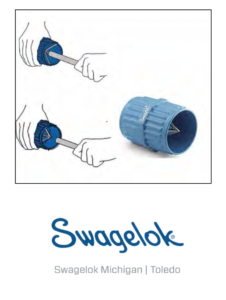 Swagelok Michigan/Toledo is an authorized sales and service center for the Swagelok Company. Founded in the 1940s, Swagelok is known for tube fittings, exotic alloys, and high-quality products for fluid systems. With 8,000 employees working in over 80 distribution centers, Swagelok is the leading supplier of fluid system components globally. Swagelok strives to find a better way. Through new products, system designs, training, and services Swagelok is focused on improving the customers’ experience.
Swagelok Michigan/Toledo is an authorized sales and service center for the Swagelok Company. Founded in the 1940s, Swagelok is known for tube fittings, exotic alloys, and high-quality products for fluid systems. With 8,000 employees working in over 80 distribution centers, Swagelok is the leading supplier of fluid system components globally. Swagelok strives to find a better way. Through new products, system designs, training, and services Swagelok is focused on improving the customers’ experience.
Swagelok offers high quality tubing in sizes up to two inches in diameter, which is cut to specified lengths for customers. When cutting, burrs are left on the interior and exterior diameters of the tubing, preventing proper use by customers. Before shipping, they must be removed. On smaller diameter tubing (up to 1 1⁄4 inches) there is currently a tool to remove the burrs. On larger diameters, it must be done by hand. The project goal was to develop a tool that can quickly and efficiently remove harsh burrs from the inside and outside diameters of stainless steel tubing for a variety of sizes. Universal milling inserts were utilized throughout the project in order to achieve cutting. Additionally, a power unit was included to create the deburring action. This way, the task is safer and easier for the operator. The tool is a rigid setup that can be used over a large size range, including the large and small diameter tubing. Therefore, the new tool allows Swagelok’s operations to be more efficient.

Team Members (L-R): Jayme Stiglich, Conner Stevenson, Ryan Kalis, Christopher Kiesling, (Sponsor), Austin Aselage, Alyssa Salciccioli
ArcelorMittal: Crane RFID Antenna Mount
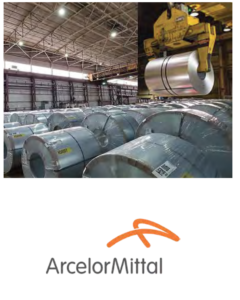 ArcelorMittal is the world’s leading integrated steel and mining company – present in 60 countries with an industrial footprint in 18 countries. Melted down iron ore pellets are cast into sheets and rolled into coils (pictured to the right) that can weigh between 50,000 and 80,000 pounds each. Many of the steel rolls look very similar but have had different treatments leading to different material properties. Accurately tracking each coil is therefore critical to ensure the customer receives the correct product. This location has integrated the use of RFID chips into several steps of the manufacturing process.
ArcelorMittal is the world’s leading integrated steel and mining company – present in 60 countries with an industrial footprint in 18 countries. Melted down iron ore pellets are cast into sheets and rolled into coils (pictured to the right) that can weigh between 50,000 and 80,000 pounds each. Many of the steel rolls look very similar but have had different treatments leading to different material properties. Accurately tracking each coil is therefore critical to ensure the customer receives the correct product. This location has integrated the use of RFID chips into several steps of the manufacturing process.
Our group is responsible for determining an optimal design for an RFID mount that allows crane operators to identify each steel coil after it is placed in the warehouse. The mill would like to expand the use of RFID technology to assist in crane pickup to generate a map of these identified coils using the mount designed by our team. The mount needs to be durable and easily attachable to the crane. The successful completion and implementation of our team’s design solution has a yearly cost-saving potential of more than $1M and will save the crane operators hours of work each month searching for the correct coil.
ArcelorMittal: Floor Plate Inversion Table
 ArcelorMittal is the world’s largest integrated steel mining and manufacturing corporation in the world. Headquartered in Luxembourg City, Luxembourg, ArcelorMittal annually produces 118 million tons of crude steel as of 2018. The corporation is a leading supplier in major North American and European markets providing steel solutions to the automotive, construction, consumer appliance and machinery industries. ArcelorMittal employs more than 200,000 people across 60 countries with significant operations in France, Germany, Belgium, Luxembourg, and Poland. In the United States alone, ArcelorMittal employs 18,000 people across 25 operations. Operations such as mining, steelmaking and finishing are fully integrated to meet a wide range of customer demands across diverse industries.
ArcelorMittal is the world’s largest integrated steel mining and manufacturing corporation in the world. Headquartered in Luxembourg City, Luxembourg, ArcelorMittal annually produces 118 million tons of crude steel as of 2018. The corporation is a leading supplier in major North American and European markets providing steel solutions to the automotive, construction, consumer appliance and machinery industries. ArcelorMittal employs more than 200,000 people across 60 countries with significant operations in France, Germany, Belgium, Luxembourg, and Poland. In the United States alone, ArcelorMittal employs 18,000 people across 25 operations. Operations such as mining, steelmaking and finishing are fully integrated to meet a wide range of customer demands across diverse industries.
In Burns Harbor, Indiana ArcelorMittal’s plant is 60 years old. Due to the age of the plant, many of the plant’s steel floor plates require maintenance. These floor plates weigh nearly 3 tons and require mechanical advantage to safely rotate them upside down for re-attachment of the support beams. The team designed an inversion table to assist in the repair of these steel floor plates. The table utilizes pressurized, piston- driven cylinders to control the motion of the floor plates as they rotate. The shear weight of the floor plates made the design more challenging as it required very robust designs. The repair of these steel floor plates greatly improves the logistic efficiency of steel transportation within the plant.

